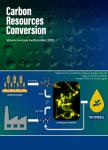Impact of hydrolysis on surface area and energy storage applications of activated carbons produced from corn fiber and soy hulls
作者机构:Conn Center for Renewable Energy ResearchUniversity of LouisvilleLouisvilleKYUSA Energy Systems LaboratoryIdaho National LaboratoryIdaho FallsIDUSA School of Chemical and Biomolecular EngGeorgia Institute of TechnologyUnited States
出 版 物:《Carbon Resources Conversion》 (碳资源转化(英文))
年 卷 期:2020年第3卷第1期
页 面:19-28页
核心收录:
学科分类:1002[医学-临床医学] 100201[医学-内科学(含:心血管病、血液病、呼吸系病、消化系病、内分泌与代谢病、肾病、风湿病、传染病)] 10[医学]
基 金:The authors wish to acknowledge the support from Brown-Forman Corporation Louisville KY. The authors also thank the technical assistance from Dr. Jacek Jasinski of Conn Center and Dr. Gabriel Draper
主 题:Agricultural residues Hydrolysis Activated carbon Surface area characterization Surface morphology
摘 要:Complete utilization of lignocellulosic biomass through the creation of value-added coproducts is one of the key strategies of the Bioenergy Technologies Office(BETO)for the cost-effective production of biofuels and biochemicals.A green approach to producing lightweight and high specific surface area(SSA)activated carbons(ACs)from sustainable biomass sources is of great interest to producers and users of energy devices such as batteries and *** direct conversion from biomass has been studied extensively,AC with relatively high surface areas can be produced more cost-effectively when leveraged as a co-product from a *** this paper,we discuss the production of high specific surface area activated carbons from residual fiber(fiber remaining after extraction of C5-sugars)generated as part of a C5 *** surface,morphological characteristics using SEM and TEM,and energy storage behavior of ACs produced using the C5 extracted residual fiber were evaluated in the present *** ACs produced from the residual fiber delivered an order of magnitude higher surface area than the one directly from corn pericarp fiber and soy *** surface area of the ACs produced from pre-hydrolysis DDG was only 10 m^(2)/g compared to 689 m^(2)/g for soy hulls whereas after hydrolysis these values increased significantly(DDG:1700 m^(2)/g and soy hulls:1300 m^(2)/g).TEM images indicated high exfoliation,explaining the change in surface area *** the same current density(500 mA/g)the cycling performance of the ACs increased as the surface area increased significantly.



